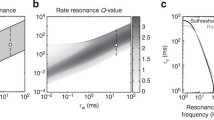Abstract
Typically, excitatory synaptic coupling is thought of as an influence that accelerates and propagates firing in neuronal networks. This paper reviews recent results explaining how, contrary to these expectations, the presence of excitatory synaptic coupling can drastically slow oscillations in a network and how localized, sustained activity can arise in a network with purely excitatory coupling, without sustained inputs. These two effects stem from interactions of excitatory coupling with two different forms of intrinsic neuronal dynamics, and both serve to highlight the fact that the influence of synaptic coupling in a network depends strongly on the intrinsic properties of cells in the network.
Similar content being viewed by others
References
Abbott LF, Regehr WG (2004) Synaptic computation. Nature 431: 796–803.
Amari S (1977) Dynamics of pattern formation in lateral–-inhibition type neural fields. Biol. Cybern. 27: 77–87.
Baer SM, Erneux T, Rinzel J (1989) The slow passage through a Hopf bifurcation: Delay, memory effects, and resonance. SIAM J. Appl. Math 49: 55–71.
Butera RJ, Rinzel J, Smith JC (1999) Models of respiratory rhythm generation in the pre-Bötzinger complex. II. Populations of coupled pacemaker neurons. J. Neurophysiol. 81: 398–415.
Diener M (1984) The canard unchained or how fast/slow dynamical systems bifurcate. Math. Intell. 6(3): 38–49.
Drover JD, Ermentrout B (2003) Nonlinear coupling near a degenerate Hopf (Bautin) bifurcation. SIAM J. Appl. Math. 63: 1627–1647.
Drover J, Rubin J, Su J, Ermentrout B (2005) Analysis of a canard mechanism by which excitatory synaptic coupling can synchronize neurons at low firing frequencies. SIAM J. Appl. Math. 65: 65–92.
Ermentrout B (1996) Type I membranes, phase resetting curves, and synchrony. Neural Comput. 8: 979–1001.
Ermentrout B (2002) Simulating, Analyzing, and Animating Dynamical Systems: A Guide to XPPAUT for Researchers and Students. SIAM, Philadelphia.
Hansel D, Mato G, Meunier C (1993) Phase dynamics for weakly coupled Hodgkin-Huxley neurons. Europhys. Lett. 23: 367.
Hansel D, Mato G, Meunier C (1995) Synchrony in excitatory neural networks. Neural Comput. 7: 307–337.
Hodgkin AL, Huxley AF (1952) A quantitative description of the membrane current and its application to conduction and excitation in nerves. J. Physiol (Lond.) 117: 500–544.
Hoppensteadt FC, Izhikevich EM (1997) Weakly Connected Neural Networks. Springer-Verlag, New York, NY.
Izhikevich E (2000). Subcritical elliptic bursting of Bautin type. SIAM J. Appl. Math. 60: 503–535.
Kopell N, Somers D (1995) Anti-phase solutions in relaxation oscillators coupled through excitatory interactions. J. Math. Biol. 33: 261–280.
Kuske R, Baer S (2002) Asymptotic analysis of noise sensitivity in a neuronal burster. Bull. Math. Biol. 64: 447–481.
Morris C, Lecar H (1981) Voltage oscillations in the barnacle giant muscle fiber. Biophys. J. 35: 193–213.
Neishtadt AI (1987) On delayed stability loss under dynamical bifurcations I. J. Diff. Eqn. 23: 1385–1390.
Neishtadt AI (1988) On delayed stability loss under dynamical bifurcations II. J. Diff. Eqn. 24: 171–176.
Renart A, Song P, Wang X-J (2003) Robust spatial working memory through homeostatic synaptic scaling in heterogeneous cortical networks. Neuron 38: 473–485.
Rinzel J (1985) Excitation dynamics: Insights from simplified membrane models. Fed. Proc. 44: 2944–2946.
Rinzel J (1987) A formal classification of bursting mechanisms in excitable systems. In: AM Gleason, ed. Proceedings of the International Congress of Mathematicians. AMS, Providence, RI, pp. 1578–1593.
Rinzel J, Ermentrout GB (1998) Analysis of neural excitability and oscillations. In: C Koch, I Segev, eds. Methods in Neuronal Modeling: From Ions to Networks, second edition. MIT Press, Cambridge, MA, pp. 251–291.
Rubin J, Bose A (2004) Localized activity patterns in excitatory neuronal networks. Network: Comp. Neural Sys. 15: 133– 158.
Rubin J, Terman D (2002) Geometric singular perturbation analysis of neuronal dynamics. In: B. Fiedler, ed. Handbook of Dynamical Systems, Vol. 2 Elsevier, Amsterdam, pp. 93–146.
Rubin J, Terman D, Chow C (2001) Localized bumps of activity sustained by inhibition in a two-layer thalamic network. J. Comp. Neurosci. 10: 313–331.
Rubin JE, Troy WC (2004) Sustained spatial patterns of activity in neuronal populations without recurrent excitation. SIAM J. Appl. Math 64: 1609–1635.
Somers D, Kopell N (1993) Rapid synchronization through fast threshold modulation. Biol. Cybern. 68: 393–407.
Su J, Rubin J, Terman D (2004) Effects of noise on elliptic bursters. Nonlinearity 17: 133–157.
Szmolyan P, Wechselberger M (2001) Canards in ℝ3. J. Diff. Eqn. 177: 419–453.
Wang X-J, Rinzel J (1995) Oscillatory and bursting properties of neurons. In: MA Arbib, ed. Handbook of Brain Theory and Neural Networks. MIT Press, Cambridge, MA, pp. 689–691.
Wechselberger M (2004) Existence and bifurcation of canards in ℝ3 in the case of a folded node. Preprint.
Wilson HR, Cowan JD (1973) A mathematical theory of the functional dynamics of cortical and thalamic nervous tissue. Kybernetic 13: 55–80.
Author information
Authors and Affiliations
Corresponding author
Additional information
This work was partially supported by the National Science Foundation, under award DMS-0414023
Rights and permissions
About this article
Cite this article
Rubin, J.E. Surprising Effects of Synaptic Excitation. J Comput Neurosci 18, 333–342 (2005). https://doi.org/10.1007/s10827-005-0340-0
Received:
Revised:
Accepted:
Issue Date:
DOI: https://doi.org/10.1007/s10827-005-0340-0




